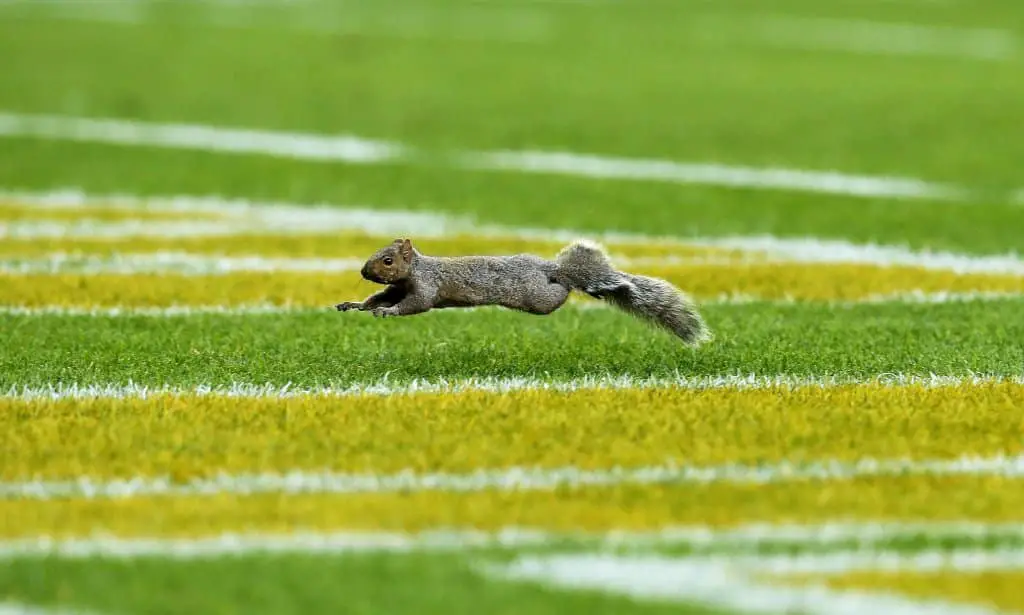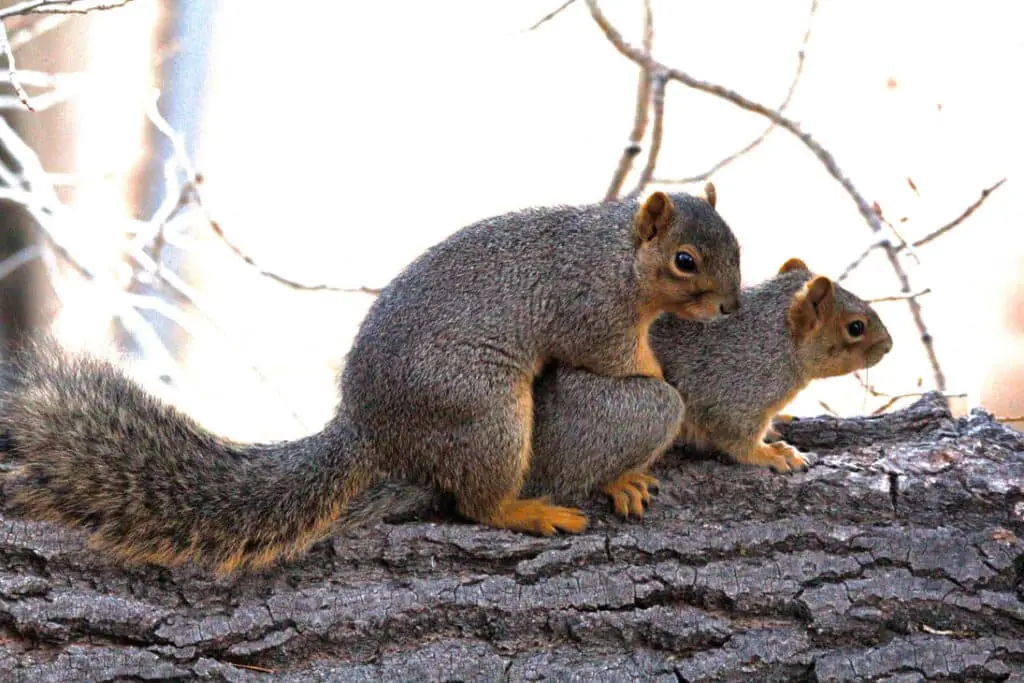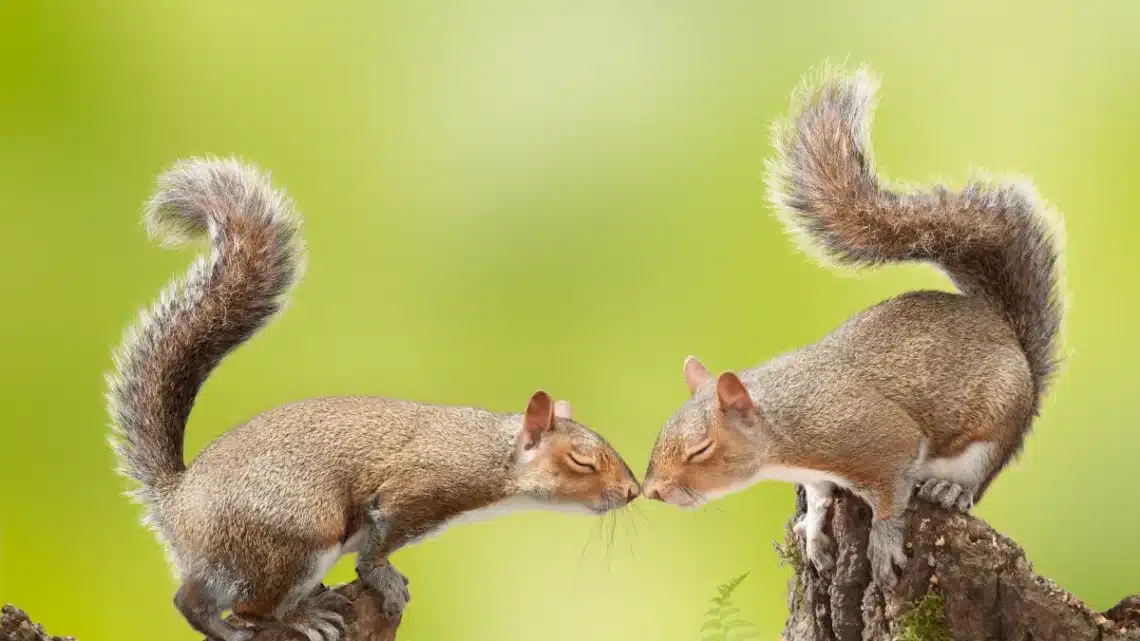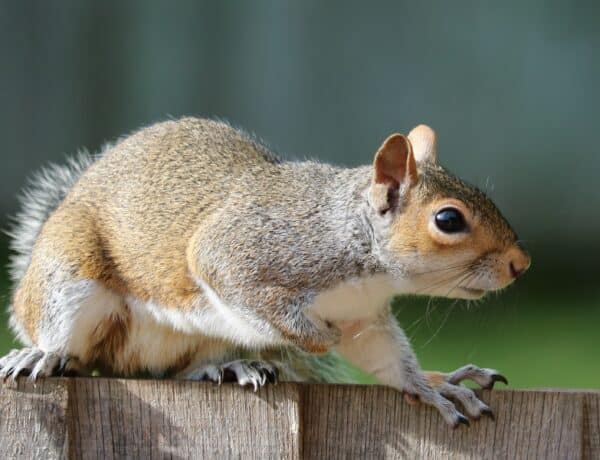Introduction
Why Do Squirrels Chase Each Other: Squirrels, those agile and energetic creatures that often inhabit our parks, gardens, and woodlands, are known for their playful and sometimes seemingly erratic behavior. One of the most fascinating and commonly observed behaviors among squirrels is their tendency to chase each other. Whether you’ve witnessed this spectacle in your backyard or during a leisurely stroll through the woods, you might have found yourself pondering the reasons behind this curious pursuit. The sight of squirrels rodents darting through trees and scampering across the ground, seemingly engaged in an elaborate game of chase, is a common occurrence for anyone who spends time in areas inhabited by these creatures.
At first glance, it may appear as though they are engaged in a lighthearted game, akin to children playing tag in a playground. However, there is much more to this behavior than meets the eye. One of the primary reasons squirrels chase each other is to establish dominance and defend their territories. Squirrels are territorial animals and can become quite protective of their food sources, nesting sites, and general living areas. Chasing another squirrel away from their territory is a way for them to assert their dominance and protect their resources. It’s essentially a high-stakes game of “stay away from my turf.”
Another significant factor contributing to squirrel chases is mating. During the breeding season, male squirrels may chase females in a frenzied pursuit, hoping to win the favor of a potential mate. This behavior is not limited to males pursuing females; sometimes, females may engage in chases to assess the suitability of a potential mate. These chases serve as a form of exercise and play for squirrels, helping to sharpen their reflexes and agility. Like many animals, squirrels need to stay in top physical condition to navigate their tree-dwelling lifestyles effectively. Chasing each other through the branches and across the ground can be an enjoyable way for them to stay fit while honing their skills.

Why are my squirrels chasing each other?
Chasing each other is part of their mating ritual, so if you witness this behavior during these times of the year, that’s probably the reason. Male squirrels chase one another to establish dominance. The dominant squirrel gets to mate with the female.
Territorial Disputes: One of the primary reasons squirrels chase each other is to establish and defend their territories. Squirrels are territorial animals, and they can become fiercely protective of their food sources, nesting sites, and living areas. When one squirrel ventures too close to another’s territory, a chase may ensue as a way to assert dominance and maintain control over valuable resources.
Mating Season: During the breeding season, which varies depending on the species and location, male squirrels may engage in frenzied chases to pursue females in an attempt to win their favor. This behavior is part of their reproductive strategy, as males vie for the opportunity to mate with receptive females. Females, too, may engage in chases as a way to assess the fitness of potential mates.
Play and Exercise: Squirrel chases also serve as a form of play and exercise. Squirrels, like many animals, need to stay in top physical condition to effectively navigate their tree-dwelling lifestyles. Chasing each other through trees and across the ground helps them sharpen their reflexes and maintain their agility. It’s essentially a fun way for squirrels to stay fit.
Why do squirrels fight and chase each other?
Aggression and chasing is an important way to establish the ranking members of the population which is important when it comes to reproduction. Dominant squirrels will chase down and nip their subordinate counterparts.
Territorial Defense: One of the primary reasons squirrels engage in fights and chases is to defend their territories. Squirrels are territorial animals, and they can be quite protective of their living spaces, food sources, and nesting sites. When another squirrel encroaches on their territory, a dispute may erupt. These fights and chases serve as a means to assert dominance and safeguard valuable resources.
Mating Competition: During the breeding season, male squirrels often compete vigorously for the attention of female squirrels. This competition can lead to fights and chases as males pursue females in an attempt to mate. The most dominant males may be more successful in securing mates, ensuring the continuation of their genetic line.
Social Hierarchy: Squirrels live in communities where social hierarchies exist. Fights and chases can help establish and maintain these hierarchies. Dominant squirrels are often the ones initiating confrontations, asserting their rank, and ensuring that subordinate squirrels respect their position within the group.
Do squirrels follow each other?
Why do grey squirrels chase each other? Fights between dominants and subordinates normally occur in the breeding and dispersal seasons, and involve chases and wrestling. Males are attracted to the scent of oestrous females. Several males will frequently follow one female and often end up chasing her.
Social Interaction: Squirrels are not solitary animals; they live in communities, often sharing territories with other squirrels. Following each other can be a form of social interaction and communication within their groups. It allows them to stay connected and coordinate activities with their fellow squirrels.
Learning from Others: Young squirrels, in particular, may follow older, more experienced individuals as a way to learn survival skills. This learning by observation can include finding food sources, navigating through the environment, and identifying potential threats. It’s a form of apprenticeship that helps younger squirrels adapt to their surroundings.
Safety in Numbers: Squirrels, like many prey animals, often adhere to the safety-in-numbers principle. When one squirrel detects a potential threat, such as a predator, it may signal its alarm by making vocalizations or behaving nervously. Other nearby squirrels may then follow the alarmed individual, trusting its judgment and seeking safety in the group.
How do squirrels show aggression?
Attacks can be sudden and apparently without warning and may be accompanied by squeaking or chittering vocalisations. Bosch and Lurz note that threatened animals may react by raising their ear tufts vertically and releasing “a menacing or piercing squeak, which can have a startling effect”.
Vocalizations: Squirrels communicate through a range of vocalizations, and when agitated or threatened, they may emit loud, sharp calls as a warning to other squirrels or potential threats. These vocalizations serve as an initial warning sign of aggression. It’s a way for squirrels to alert others to their presence and assert their territorial boundaries.
Chasing: One of the most noticeable forms of aggression among squirrels is chasing. Squirrels may pursue each other or other animals, including humans, when they feel their territory is being invaded or when they are engaged in mating competition. These chases can be intense and fast-paced, with the aggressor attempting to drive the intruder away.
Biting and Scratching: In extreme cases of aggression or when physical conflict becomes unavoidable, squirrels may resort to biting and scratching. This can occur during territorial disputes, competition for resources, or when they feel cornered and threatened. Squirrel bites can be painful and may carry a risk of disease transmission.
Are squirrels intelligent?
All rodents are intelligent animals, but the squirrel crowns the list for intelligence. While a rat/mouse can outsmart and sometimes outmaneuver a pursuing human, squirrels’ quickness and intellect give them a lead over other predators and more giant creatures.
Food Caching: One of the most well-known signs of squirrel intelligence is their ability to cache, or hide, food for later consumption. Squirrels are known to bury nuts and seeds in various locations, creating a mental map of their cache sites. This demonstrates their ability to plan for the future, specific locations, and solve problems related to resource management.
Memory: Squirrels rely heavily on memory to locate their food caches. Studies have shown that they can the locations of hundreds of individual caches, even months after burying them. This long-term memory and spatial awareness are indicative of their intelligence.
Problem Solving: Squirrels often encounter obstacles when foraging for food. They have been observed solving problems, such as figuring out how to access bird feeders or navigate complex mazes to reach a reward. These instances demonstrate their ability to adapt and find creative solutions to challenges.
Do squirrels chase humans?
Most of the time, they aren’t.
If you approach most squirrels, they’ll run away. However, squirrels have been known to attack children, pets, and adults. There are many documented cases of squirrels attacking and inflicting wounds.
Territorial Behavior: Squirrels are territorial animals and can be quite protective of their living spaces, especially during breeding seasons or when they have young offspring in nests. In some cases, a squirrel may perceive a human’s presence as a potential threat to its territory, and as a result, it may display aggressive behavior, which can include chasing.
Mistaken Identity: Squirrels have relatively poor eyesight and may sometimes mistake a human for a potential predator or a threat. In such instances, a squirrel may engage in a brief chase to ward off what it perceives as a danger.
Defensive Behavior: Squirrels are relatively small animals, and their primary means of defense against predators is to flee or engage in evasive maneuvers. If a squirrel feels cornered or trapped, it may resort to chasing as a last-ditch effort to escape the perceived threat.
Protecting Young: If a mother squirrel has young offspring in a nest nearby, she may become particularly defensive and aggressive if she perceives a human as a threat to her babies. In such cases, she may engage in chasing behavior to keep the potential danger away.
Why do baby squirrels chase you?
When older baby squirrels are orphaned, they get so hungry and desperate that they will run right up to people. They might crawl up your pant leg or sit on your shoe. It happens often enough that our wildlife hotline has a word for these older orphaned babies: “pant tuggers”.
Curiosity: Baby animals, including squirrels, are naturally curious. They are in the early stages of learning about their environment, and they may approach humans out of curiosity. What might appear as chasing could simply be an attempt to get closer to explore or investigate something unfamiliar.
Mistaken Identity: Baby squirrels have limited experience and may sometimes mistake humans for their parents or other animals they interact with in their natural habitat. If a baby squirrel follows a person, it might be because it associates the person with a source of comfort, warmth, or food.
Imprinting: Imprinting is a phenomenon where young animals bond with the first moving object they see, often their parent. If a baby squirrel is raised by humans or has been exposed to them from a very young age, it may develop an attachment to people and seek their company.
Playful Behavior: Baby animals, including squirrels, engage in play to develop essential skills. What may appear as chasing could be a form of play, where the baby squirrel is practicing its agility, coordination, and social skills. This behavior is not necessarily aggressive.
Do squirrels mourn each other?
Although it’s unclear whether squirrels feel grief or sadness, squirrels have been known to move the body of another dead squirrel or stay with the body of a fellow dead squirrel. In this situation, squirrels display similar behaviors—sitting upright, looking distressed, and making repeated grooming movements.
Social Bonds: Squirrels are not solitary creatures; they often live in communities and interact with each other. In these social groups, they form bonds with other squirrels, particularly those within their immediate family or territory. When a member of their group dies or is lost, it’s possible that surviving squirrels may exhibit behaviors consistent with mourning, such as increased vigilance or agitation.
Change in Behavior: Observations by researchers and wildlife enthusiasts have noted changes in the behavior of squirrels when they lose a close companion. They may become less active, vocalize differently, or display signs of distress. These changes could be interpreted as a reaction to the absence of a fellow squirrel.
Protection of Remains: In some cases, squirrels have been observed guarding the body or remains of a dead companion. This protective behavior suggests that they recognize the significance of the deceased individual and may be attempting to prevent scavengers or predators from desecrating the body.

Conclusion
The phenomenon of squirrels chasing each other, while initially appearing as a whimsical game, reveals a fascinating world of social interactions, territorial disputes, and reproductive strategies among these ubiquitous rodents. The reasons behind this behavior are multifaceted, shedding light on the intricacies of squirrel life and survival. First and foremost, squirrel chases serve as a means of establishing dominance and protecting valuable resources. These creatures are territorial by nature, and defending their turf is paramount to their survival. By chasing intruders away, squirrels safeguard their food sources, nesting sites, and the safety of their young.
It’s a strategic move that underscores their squirrel abilities to adapt to and thrive in diverse environments. Additionally, during the breeding season, the chase takes on a new dimension, as males pursue females in a quest to secure a mate. This reproductive-driven behavior is a testament to the evolutionary imperative to pass on their genetic legacy. Female squirrels may also engage in chases to assess the fitness of potential partners, ensuring the survival of their offspring. Beyond the practical aspects, squirrel chases offer a form of exercise and play. These activities are crucial for maintaining their physical fitness and honing their agility, both of which are essential for their tree-dwelling lifestyle.
Squirrels are remarkably adept at leaping between branches, scurrying up tree trunks, and navigating complex terrains. Engaging in chases helps them refine these skills, preparing them to face the challenges of their environment. In the grand tapestry of the natural world, squirrel chases are a testament to the intricate web of behaviors that contribute to the survival and perpetuation of a species. These chases, while seemingly frivolous at times, are a vital component of the squirrels’ daily lives, embodying the complex interplay of instinct, adaptation, and social dynamics. Next time you encounter a group of squirrels engaged in a spirited chase, take a moment to appreciate the deeper significance of their actions. Behind those lightning-quick sprints and nimble acrobatics lies a story of survival, competition, and the relentless drive of nature to perpetuate life.





No Comments